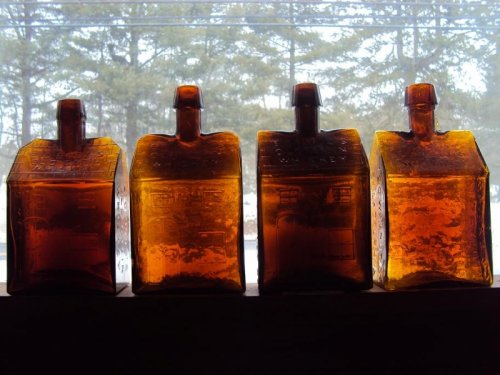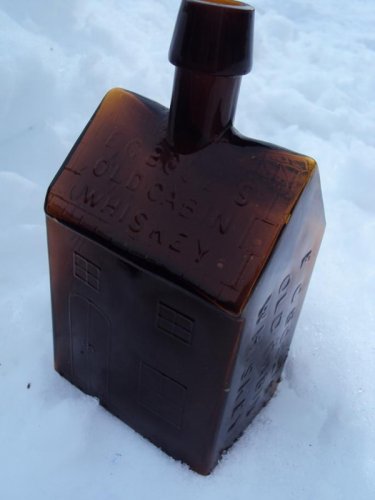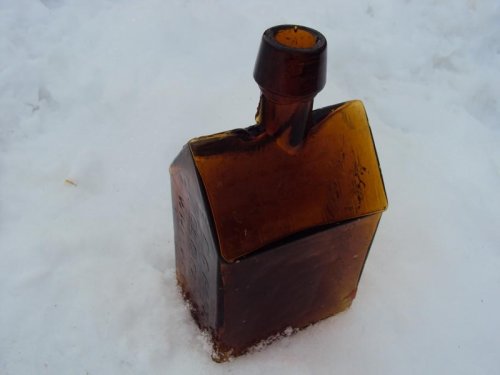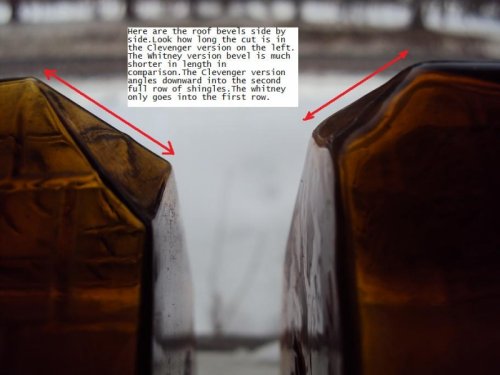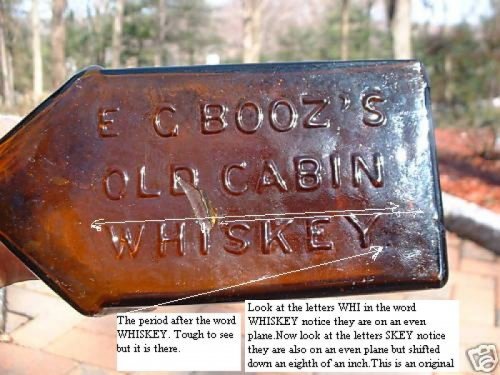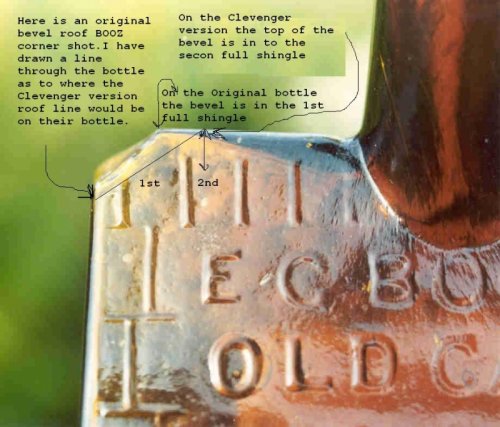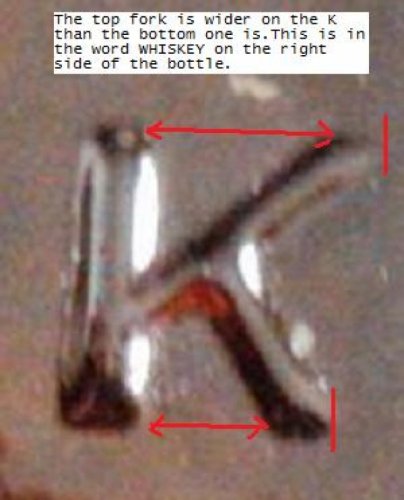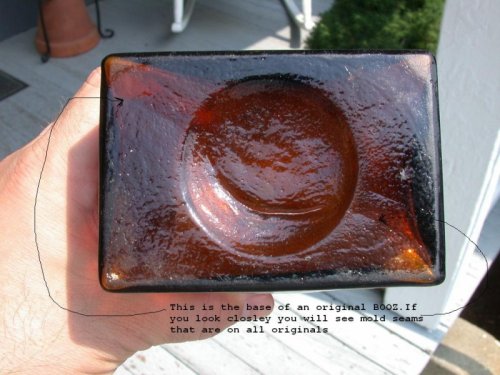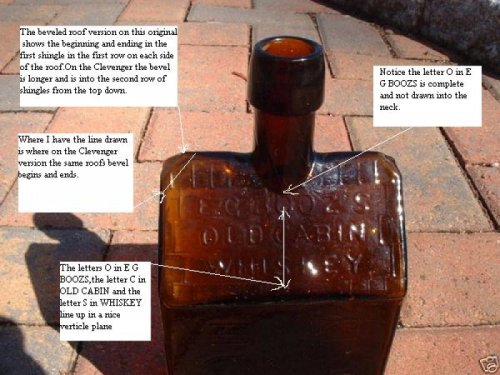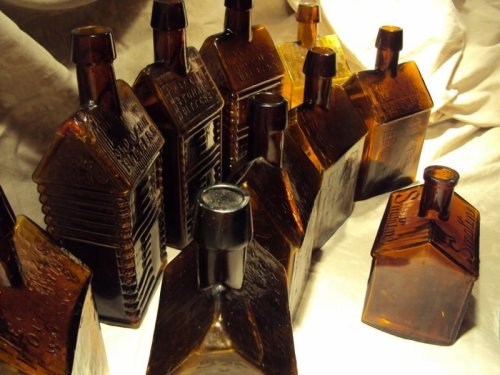Steve/sewell
Well-Known Member
- Joined
- Jan 23, 2010
- Messages
- 6,108
- Reaction score
- 5
- Points
- 0
Here are is the GVII-3 and GVII-4 Cabin style E G BOOZ'S OLD CABIN WHISKEY /
120 WALNUT STREET PHILADELPHIAbottles.
These are some of the most desired and pricey bottles available in the bottle collecting world.
It is also the most reproduced antique bottle on the Market.The Clevenger brothers made the best copy in 1930
of the straight roof version and have fooled quite a few people myself included. I will show also in this
post a Clevenger for refferance to the ability to determine an original from the Clevengers.
Only one GVII-5 exists and that is in the Corning Museum of glass.
While not extremely rare GVII-3 is none the less not to common and has a high percentage of roof
and corner damage because of the thinness of the glass in those area's of the bottle.It was difficult to blow
the glass into the bottles corners and crevices thus the bottles were weak at those points.This is why the
roof variant on the GVII-4 with the beveled roof was changed. Metal plugs were added in the corner peaks of
the roof to acheive this.
The bottle was manufactured at the Whitney glass works in Glassboro New Jersey
in the years 1858 through the 1860s.The Whitney glass works had a retail office in Philadelphia at
118 Walnut street and right next door to them Edmund G. Booz had his store front where he was
selling his cabin shaped Booz bottles to liquor merchants and tavern owners through out the
Delaware Valley.There was speculation that the bottles manufacture date was in the year 1840
but that has since been disproved as Edmund Booz would have been only sixteen years of age at that time,
an age probably a little to young to ba a liquor merchant.
The original bottle had a paper label wrapper that depicted an early American cabin.
On the rear of the bottle on the roof is the date in bold font 1840.
This led many to beleive that the bottles date stamped on the roof was from William Henry Harrison's
presidential Campaign Log cabin and hard cider in the year 1840.
Early in the 20th century Edwin Atlee Barbers book titled American glassware and the book by
Stephen Van Rensselaer's American Bottle's and Flasks only fueled the myth regaurding the Harrison
presidential campaign.
A publication in 1926 by Hazel Mirkil in the magazine Antiques proved the 120 Walnut had not been in
existance before the year 1856 as the city of Philadelphia had renumbered their streets in that year.
The reason the city renumbered was simple the Center City portion was growing and
it was easier to label blocks in the city as the 100 block 200 block ect.
The old address of Boozs store would have been 26 Walnut street.
Booz also had a property directly behind 120 walnut street at 15 Granite street.
The city again changed the numering system as front street became the waterfront street.
In the Days Dyott had his factory first street was right on the river.
In fact all of the important business locals were on the river for easy access of shipping of goods.
In the early seventies the buliding of interstate I-95 in the city followed the Delaware river right where
first street was located it was removed.By the way lots of bottles and artifacts from the colonial times were
found during the heavy earth moving excavations.
There is sound justification that the mold maker who the Whitney glass works used for the bottle
modeled his cabin in the image of a glass workers home which in the early 1840s through up to 1970
dotted the landscape surrounding the old Whitney Glass works location in the heart of Glassboro.
The glass workers lived in small modest 4 room 2 story homes shaped exactly like the Booz bottle.
When you peeled the label off the bottle it now closley resembled the glass workers homes.
The last vestages of these old homes came down in 2007 as part of the down town revitalization project
the town of Glassboro was instituting.Glassboro has done a terrible job preserving its rich glass industry.
Only a handfull of the original colonial homes still stand today.The 5 point intersection where the Stangers had founded
the second glass works in New Jersey has lost all of its historic charm with the original Stanger mansion house as the only
standing structure from the original works.
Here are the Characteristics and measurements of the original Booz bottles.
The bottle was blown in a hinged mold which opened and closed diagonally.
A treadle mold was used applying foot power to the mold which allowed the master blower to close the mold around
the gather of glass when blowing into it and than opening it when he was finished blowing the bottle.
When the bottle was released from the mold it sat on a steel pedestal 2 7/8s in diameter.With the bottle now resting on the pedestal the slight circular depression seen on all of the Booz base's was left.The pedestal had been designed to move
independently resting on a large pin.When the glass blower was finished blowing the bottle he was able to move the bottle
towards him for easy removal from the mold.With the bottle now removed from the mold the blow over portion of the glass was cracked off.Now it was the gaffers turn to place the the applied top to the bottle. Once that task was completed the
bottle was placed into the annealing oven which had a lower temperature than the main furnace which allowed the bottle to gradually cool.
GVII-3 E. G. BOOZ'S / OLD CAIN WHISKEY
Type: Shaped in the style of a small two story cabin or house.
The place of manufacture: The Whitney Glass Works Glassboro New Jersey
Main /High and State streets.
Date of Manufacture. 1858 possibly right up to 1870
Heigth of the bottle: 7 1/2, 7 5/8s and 7 3/4 inches
Width of the bottle: 4 1/16 inches.
Depth of the bottle: 2 7/8 at the base and 3 inches at the roof line.
The neck and lip 1 3/4 inches in total height.Finished with an applied sloping collar.
The Base of the bottle: Smooth with a circular impression 1/8 inch in depth by 2 7/8 in circumference.
There are two horizontal seams about a half of an inch in from the corners
opposing each other diagonally
The roof line: Straight ridge 4 inches in length.
The front Roof design and embossing:The roof has 5 square rows of shingles in various sizes.
The roof is 4 inches wide by 2 3/4 inches tall.
The following inscription : E G BOOZ'S OLD CABIN WHISKEY in 3/8 inch font.
The rear roof design and embossing : The roof has 5 square rows of shingles in various sizes.
The roof is 4 inches wide by 2 3/4 inches tall.
The following inscription : 1840 in bold larger 1/2 inch font.
The right side: The embossing in three rows E G BOOZ'S OLD CABIN WHISKEY.
The left side : The embossing in two rows 120 WALNUT ST PHILADELPHIA (there are two dots below the t in ST)
The back side of the bottle: Smooth plain no inscription a large label was placed here originally.
The colors the bottle is found in: Predominantly in medium orange amber with varying shades,Some pale amber,
Dark green,and a pale green.I personaly have never seen anywhere a color other than
the amber.I have seen dark and lighter shades of Amber only on this bottle.
The only sure fire ways to identify an original Whitney made GVII-3 Booz from the Clevenger version are as follows.
On the original bottle on the right hand side the word WHISKEY has two identifying marks which clearly show the difference between it and the Clevenger bottle.There is a period after the word WHISKEY on all the original.Sometimes because of a weak mold impression the period is faint but it is usually there none the less.The second identifying trait is when viewing the word WHISKEY left to right the first three letters WHI are on the same horizontal plane however beginning with the letter S the
the letters SKEY are shifted down slightly on a lower horizontal plane.On the Clevenger version the word WHISKEY lines up
nice left to right on the same horizontal plane.The top fork in the letter K in the word WHISKEY is wider than the bottom fork
on the same letter.The Base the the letter G in E.G. BOOZ'S is closed on the clevenger version the G resembles a letter C thus you
see the incorrect listing on ebay all of the time E.C.BOOZ'S
Next on the front roof the embossing in three lines reads like this E.G.BOOZ'S
OLD CABIN
WHISKEY
When looking at the letters the following is true on all original BOOZ bottles.The C in the word CABIN should be directly
below the first O in the word BOOZ'S.The letter S in the word WHISKEY should be directly below the C in the word CABIN
You should be able to draw a straight line down through these letters where they line up.
GVII-4 E. G. BOOZ'S / OLD CAIN WHISKEY
Type: Shaped in the style of a small two story cabin or house.
The place of manufacture: The Whitney Glass Works Glassboro New Jersey
Main /High and State streets.
Date of Manufacture. 1858 possibly right up to 1870
Heigth of the bottle: 7 1/2, 7 5/8s and 7 3/4 inches
Width of the bottle: 4 1/16 inches.
Depth of the bottle: 2 7/8 at the base and 3 inches at the roof line.
The neck and lip 1 3/4 inches in total height.Finished with an applied sloping collar.
The Base of the bottle: Smooth with a circular impression 1/8 inch in depth by 2 7/8 in circumference.
The roof line: Straight ridge 4 inches in length.This is where this version is different than the GVII-3
Where the roof meets the gables on each side the molds sharp
corners werer beveled by placing metal plugs into the mold
This simple alteration made for a much sturdier roof.
The front Roof design and embossing:The roof has 5 square rows of shingles in various sizes.
The roof is 4 inches wide by 2 3/4 inches tall.
The following inscription : E G BOOZ'S OLD CABIN WHISKEY in 3/8 inch font.
The rear roof design and embossing : The roof has 5 square rows of shingles in various sizes.
The roof is 4 inches wide by 2 3/4 inches tall.
The following inscription : 1840 in bold larger 1/2 inch font.
The right side: The embossing in three rows E G BOOZ'S OLD CABIN WHISKEY.
The left side : The embossing in two rows 120 WALNUT ST PHILADELPHIA (there are two dots below the t in ST)
The back side of the bottle: Smooth plain no inscription a large label was placed here originally.
The colors the bottle is found in: Predominantly in medium orange amber with varying shades,Some pale amber,
Dark green,and a pale green.I personaly have never seen anywhere a color other than
the amber.I have seen dark and lighter shades of Amber only on this bottle.
The only sure fire ways to identify an original Whitney made GVII-4 Booz from the Clevenger version are as follows.
The bevel cuts at each end of the roof only extend downward into the first full row of shingles
On the original bottle on the right hand side the word WHISKEY has two identifying marks which clearly show the difference between it and the Clevenger bottle.There is a period after the word WHISKEY on all the original.Sometimes because of a weak mold impression the period is faint but it is usually there none the less.The second identifying trait is when viewing the word WHISKEY left to right the first three letters WHI are on the same horizontal plane however beginning with the letter S the
the letters SKEY are shifted down slightly on a lower horizontal plane.On the Clevenger version the word WHISKEY lines up
nice left to right on the same horizontal plane.The top fork in the letter K in the word WHISKEY is wider than the bottom fork
on the same letter.The Base the the letter G in E.G. BOOZ'S is closed on the clevenger version the G resembles a letter C thus you
see the incorrect listing on ebay all of the time E.C.BOOZ'S
Next on the front roof the embossing in three lines reads like this E.G.BOOZ'S
OLD CABIN
WHISKEY
When looking at the letters the following is true on all original BOOZ bottles.The C in the word CABIN should be directly
below the first O in the word BOOZ'S.The letter S in the word WHISKEY should be directly below the C in the word CABIN
You should be able to draw a straight line down through these letters where they line up.
Here is a group shot of the the Original Booz bottles and their Clevenger counterparts.
Left to right the Clevenger beveled roof,the original Whitney beveled roof,
The original Whitney straight roof and the Clevenger straight roof.
Notice how the amber fades to orange and than yellow at the edges and corners of the bottles.

120 WALNUT STREET PHILADELPHIAbottles.
These are some of the most desired and pricey bottles available in the bottle collecting world.
It is also the most reproduced antique bottle on the Market.The Clevenger brothers made the best copy in 1930
of the straight roof version and have fooled quite a few people myself included. I will show also in this
post a Clevenger for refferance to the ability to determine an original from the Clevengers.
Only one GVII-5 exists and that is in the Corning Museum of glass.
While not extremely rare GVII-3 is none the less not to common and has a high percentage of roof
and corner damage because of the thinness of the glass in those area's of the bottle.It was difficult to blow
the glass into the bottles corners and crevices thus the bottles were weak at those points.This is why the
roof variant on the GVII-4 with the beveled roof was changed. Metal plugs were added in the corner peaks of
the roof to acheive this.
The bottle was manufactured at the Whitney glass works in Glassboro New Jersey
in the years 1858 through the 1860s.The Whitney glass works had a retail office in Philadelphia at
118 Walnut street and right next door to them Edmund G. Booz had his store front where he was
selling his cabin shaped Booz bottles to liquor merchants and tavern owners through out the
Delaware Valley.There was speculation that the bottles manufacture date was in the year 1840
but that has since been disproved as Edmund Booz would have been only sixteen years of age at that time,
an age probably a little to young to ba a liquor merchant.
The original bottle had a paper label wrapper that depicted an early American cabin.
On the rear of the bottle on the roof is the date in bold font 1840.
This led many to beleive that the bottles date stamped on the roof was from William Henry Harrison's
presidential Campaign Log cabin and hard cider in the year 1840.
Early in the 20th century Edwin Atlee Barbers book titled American glassware and the book by
Stephen Van Rensselaer's American Bottle's and Flasks only fueled the myth regaurding the Harrison
presidential campaign.
A publication in 1926 by Hazel Mirkil in the magazine Antiques proved the 120 Walnut had not been in
existance before the year 1856 as the city of Philadelphia had renumbered their streets in that year.
The reason the city renumbered was simple the Center City portion was growing and
it was easier to label blocks in the city as the 100 block 200 block ect.
The old address of Boozs store would have been 26 Walnut street.
Booz also had a property directly behind 120 walnut street at 15 Granite street.
The city again changed the numering system as front street became the waterfront street.
In the Days Dyott had his factory first street was right on the river.
In fact all of the important business locals were on the river for easy access of shipping of goods.
In the early seventies the buliding of interstate I-95 in the city followed the Delaware river right where
first street was located it was removed.By the way lots of bottles and artifacts from the colonial times were
found during the heavy earth moving excavations.
There is sound justification that the mold maker who the Whitney glass works used for the bottle
modeled his cabin in the image of a glass workers home which in the early 1840s through up to 1970
dotted the landscape surrounding the old Whitney Glass works location in the heart of Glassboro.
The glass workers lived in small modest 4 room 2 story homes shaped exactly like the Booz bottle.
When you peeled the label off the bottle it now closley resembled the glass workers homes.
The last vestages of these old homes came down in 2007 as part of the down town revitalization project
the town of Glassboro was instituting.Glassboro has done a terrible job preserving its rich glass industry.
Only a handfull of the original colonial homes still stand today.The 5 point intersection where the Stangers had founded
the second glass works in New Jersey has lost all of its historic charm with the original Stanger mansion house as the only
standing structure from the original works.
Here are the Characteristics and measurements of the original Booz bottles.
The bottle was blown in a hinged mold which opened and closed diagonally.
A treadle mold was used applying foot power to the mold which allowed the master blower to close the mold around
the gather of glass when blowing into it and than opening it when he was finished blowing the bottle.
When the bottle was released from the mold it sat on a steel pedestal 2 7/8s in diameter.With the bottle now resting on the pedestal the slight circular depression seen on all of the Booz base's was left.The pedestal had been designed to move
independently resting on a large pin.When the glass blower was finished blowing the bottle he was able to move the bottle
towards him for easy removal from the mold.With the bottle now removed from the mold the blow over portion of the glass was cracked off.Now it was the gaffers turn to place the the applied top to the bottle. Once that task was completed the
bottle was placed into the annealing oven which had a lower temperature than the main furnace which allowed the bottle to gradually cool.
GVII-3 E. G. BOOZ'S / OLD CAIN WHISKEY
Type: Shaped in the style of a small two story cabin or house.
The place of manufacture: The Whitney Glass Works Glassboro New Jersey
Main /High and State streets.
Date of Manufacture. 1858 possibly right up to 1870
Heigth of the bottle: 7 1/2, 7 5/8s and 7 3/4 inches
Width of the bottle: 4 1/16 inches.
Depth of the bottle: 2 7/8 at the base and 3 inches at the roof line.
The neck and lip 1 3/4 inches in total height.Finished with an applied sloping collar.
The Base of the bottle: Smooth with a circular impression 1/8 inch in depth by 2 7/8 in circumference.
There are two horizontal seams about a half of an inch in from the corners
opposing each other diagonally
The roof line: Straight ridge 4 inches in length.
The front Roof design and embossing:The roof has 5 square rows of shingles in various sizes.
The roof is 4 inches wide by 2 3/4 inches tall.
The following inscription : E G BOOZ'S OLD CABIN WHISKEY in 3/8 inch font.
The rear roof design and embossing : The roof has 5 square rows of shingles in various sizes.
The roof is 4 inches wide by 2 3/4 inches tall.
The following inscription : 1840 in bold larger 1/2 inch font.
The right side: The embossing in three rows E G BOOZ'S OLD CABIN WHISKEY.
The left side : The embossing in two rows 120 WALNUT ST PHILADELPHIA (there are two dots below the t in ST)
The back side of the bottle: Smooth plain no inscription a large label was placed here originally.
The colors the bottle is found in: Predominantly in medium orange amber with varying shades,Some pale amber,
Dark green,and a pale green.I personaly have never seen anywhere a color other than
the amber.I have seen dark and lighter shades of Amber only on this bottle.
The only sure fire ways to identify an original Whitney made GVII-3 Booz from the Clevenger version are as follows.
On the original bottle on the right hand side the word WHISKEY has two identifying marks which clearly show the difference between it and the Clevenger bottle.There is a period after the word WHISKEY on all the original.Sometimes because of a weak mold impression the period is faint but it is usually there none the less.The second identifying trait is when viewing the word WHISKEY left to right the first three letters WHI are on the same horizontal plane however beginning with the letter S the
the letters SKEY are shifted down slightly on a lower horizontal plane.On the Clevenger version the word WHISKEY lines up
nice left to right on the same horizontal plane.The top fork in the letter K in the word WHISKEY is wider than the bottom fork
on the same letter.The Base the the letter G in E.G. BOOZ'S is closed on the clevenger version the G resembles a letter C thus you
see the incorrect listing on ebay all of the time E.C.BOOZ'S
Next on the front roof the embossing in three lines reads like this E.G.BOOZ'S
OLD CABIN
WHISKEY
When looking at the letters the following is true on all original BOOZ bottles.The C in the word CABIN should be directly
below the first O in the word BOOZ'S.The letter S in the word WHISKEY should be directly below the C in the word CABIN
You should be able to draw a straight line down through these letters where they line up.
GVII-4 E. G. BOOZ'S / OLD CAIN WHISKEY
Type: Shaped in the style of a small two story cabin or house.
The place of manufacture: The Whitney Glass Works Glassboro New Jersey
Main /High and State streets.
Date of Manufacture. 1858 possibly right up to 1870
Heigth of the bottle: 7 1/2, 7 5/8s and 7 3/4 inches
Width of the bottle: 4 1/16 inches.
Depth of the bottle: 2 7/8 at the base and 3 inches at the roof line.
The neck and lip 1 3/4 inches in total height.Finished with an applied sloping collar.
The Base of the bottle: Smooth with a circular impression 1/8 inch in depth by 2 7/8 in circumference.
The roof line: Straight ridge 4 inches in length.This is where this version is different than the GVII-3
Where the roof meets the gables on each side the molds sharp
corners werer beveled by placing metal plugs into the mold
This simple alteration made for a much sturdier roof.
The front Roof design and embossing:The roof has 5 square rows of shingles in various sizes.
The roof is 4 inches wide by 2 3/4 inches tall.
The following inscription : E G BOOZ'S OLD CABIN WHISKEY in 3/8 inch font.
The rear roof design and embossing : The roof has 5 square rows of shingles in various sizes.
The roof is 4 inches wide by 2 3/4 inches tall.
The following inscription : 1840 in bold larger 1/2 inch font.
The right side: The embossing in three rows E G BOOZ'S OLD CABIN WHISKEY.
The left side : The embossing in two rows 120 WALNUT ST PHILADELPHIA (there are two dots below the t in ST)
The back side of the bottle: Smooth plain no inscription a large label was placed here originally.
The colors the bottle is found in: Predominantly in medium orange amber with varying shades,Some pale amber,
Dark green,and a pale green.I personaly have never seen anywhere a color other than
the amber.I have seen dark and lighter shades of Amber only on this bottle.
The only sure fire ways to identify an original Whitney made GVII-4 Booz from the Clevenger version are as follows.
The bevel cuts at each end of the roof only extend downward into the first full row of shingles
On the original bottle on the right hand side the word WHISKEY has two identifying marks which clearly show the difference between it and the Clevenger bottle.There is a period after the word WHISKEY on all the original.Sometimes because of a weak mold impression the period is faint but it is usually there none the less.The second identifying trait is when viewing the word WHISKEY left to right the first three letters WHI are on the same horizontal plane however beginning with the letter S the
the letters SKEY are shifted down slightly on a lower horizontal plane.On the Clevenger version the word WHISKEY lines up
nice left to right on the same horizontal plane.The top fork in the letter K in the word WHISKEY is wider than the bottom fork
on the same letter.The Base the the letter G in E.G. BOOZ'S is closed on the clevenger version the G resembles a letter C thus you
see the incorrect listing on ebay all of the time E.C.BOOZ'S
Next on the front roof the embossing in three lines reads like this E.G.BOOZ'S
OLD CABIN
WHISKEY
When looking at the letters the following is true on all original BOOZ bottles.The C in the word CABIN should be directly
below the first O in the word BOOZ'S.The letter S in the word WHISKEY should be directly below the C in the word CABIN
You should be able to draw a straight line down through these letters where they line up.
Here is a group shot of the the Original Booz bottles and their Clevenger counterparts.
Left to right the Clevenger beveled roof,the original Whitney beveled roof,
The original Whitney straight roof and the Clevenger straight roof.
Notice how the amber fades to orange and than yellow at the edges and corners of the bottles.


